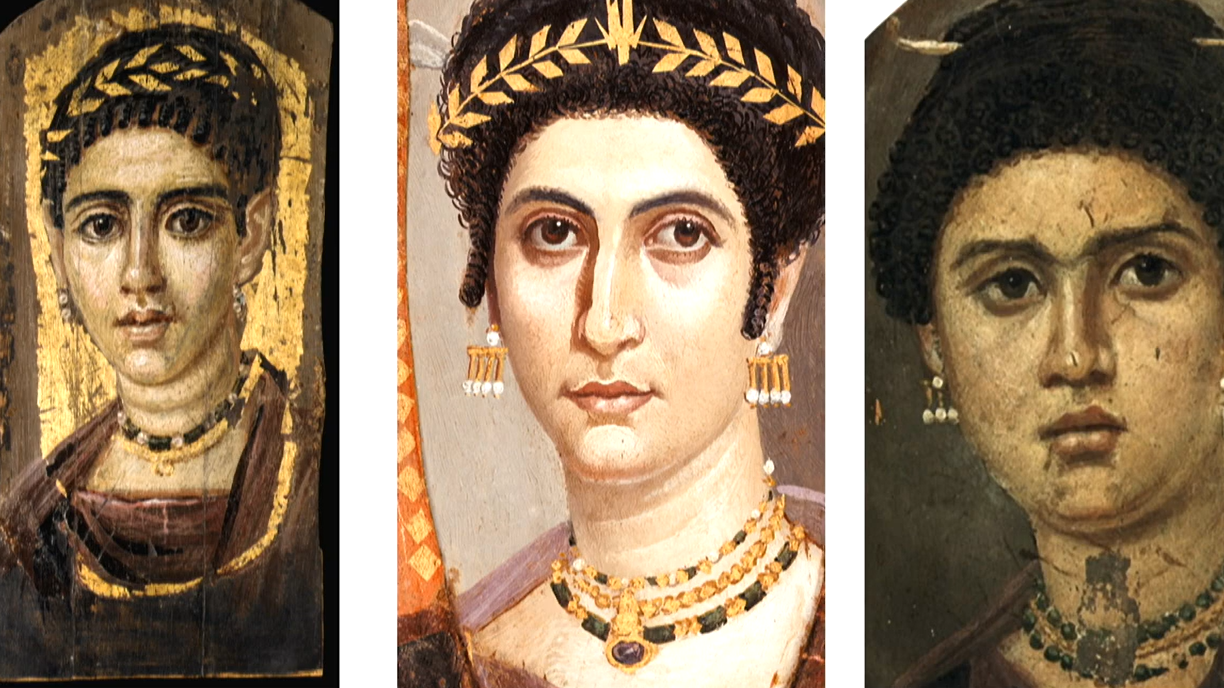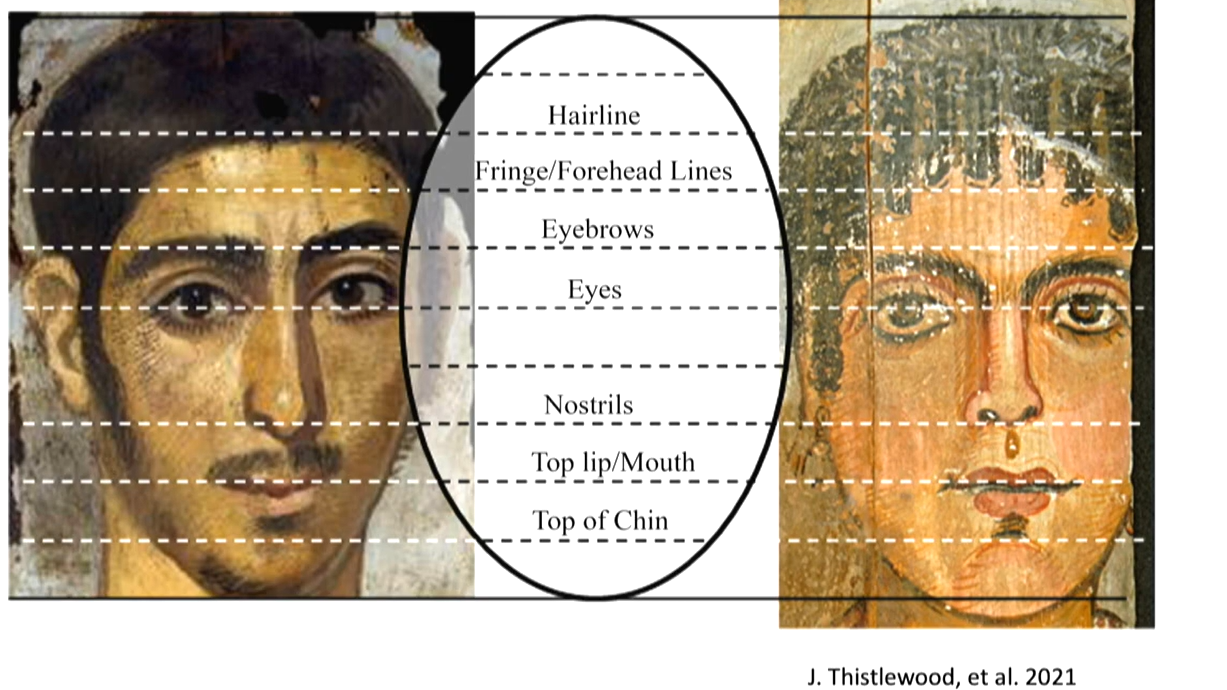Faces of the Afterlife: Egypt's Mummy Portraits

By Yara Marei/Arab America contributing writer.
In the town of Philadelphia. A grieving family gathers around their loved one’s lifeless body, preparing for a ritual as old as the sands of the Nile. Centuries later, these masks and portraits resurface, their vibrant colors and lifelike gazes transcending the veil of time. These faces stare back from antiquity to the modern observer, speaking of a world where art, religion, and identity intertwine. They tell stories of the death and life of a society grappling with multicultural influences, blending Egyptian traditions with Greek and Roman artistry.Who were these individuals immortalized in gilded masks and painted portraits? What secrets lie behind their jewelry, clothing, and intricate funerary practices? More to be Discovered with Yara Marei, Arab America contributing writer.
This article delves into the world of ancient Egyptian burial practices during the Ptolemaic and Roman periods, uncovering the mysteries of their spellbinding funerary art. From the enduring significance of the Book of the Dead to the rich symbolism in mummy portraits, these artifacts reveal a civilization’s timeless desire to bridge the mortal and the divine.
Fayoum Discoveries
Under the sands of Egypt, archaeologists uncovered remarkable treasures in Fayoum, shedding light on a vibrant blend of ancient cultures. Central to their findings was a grand funerary building with colorful gypsum-tiled floors, accompanied by a hall with remnants of four columns. Among these discoveries were Fayoum mummy portraits, strikingly realistic paintings of the deceased on wooden panels, once adorning coffins. These portraits, reflecting Egyptian, Greek, and Roman influences, provide an intimate glimpse into life during Roman Egypt, illustrating varied social and economic statuses through embalming techniques and artistry.
The excavation also unearthed Greek and Demotic inscriptions, offering insights into the social and religious standings of the individuals buried there. A terracotta statue of Isis-Aphrodite was another highlight, symbolizing the fusion of Egyptian and Greek beliefs, with Isis merging with Aphrodite. These findings continue to enrich our understanding of Fayoum as a cultural and religious melting pot, connecting us to the daily lives, traditions, and artistry of ancient times.
The Most Beautiful Face Among the Gods
The title of this exploration, “The Most Beautiful Face among the Gods,” comes from spell 151 of the Book of the Dead, a collection of spells intended to guide the deceased from life on earth to the afterlife. This article examines how ancient Egyptian burial practices, particularly the use of gilded cartonnage masks from the Ptolemaic and Roman periods, preserved continuity in afterlife beliefs and customs.
Spell 151 and Its Importance

Spell 151 is among the most notable texts in the Book of the Dead. Known as early as the 13th to 16th dynasties, it became popular again during the New Kingdom and persisted into the Roman period, specifically on mummy masks. The spell directly addresses the mummy mask, equating the features with deities to ensure safe passage into the afterlife.
Key phrases like “Hail, beautiful face” emphasize the divine nature of the mask’s features, a motif echoed throughout ancient and Roman Egypt. Spell 133 further emphasizes acceptance into the realm of the gods, reflecting the enduring spiritual significance of these artifacts.
Artistic Techniques and Cultural Influence

The mummy masks and painted portraits were significant elements in burial rituals. Three-dimensional masks, crafted from materials like cartonnage or plaster, borrowed techniques from Roman art found at Pompeii and Herculaneum. These artifacts, including the so-called portrait mummies, were produced using styles that blended Egyptian and Roman traditions.
Portrait mummies, with two-dimensional painted faces, have been unearthed in regions like Luxor and Aswan, but scholars debate their use before incorporation into burial customs. Some argue these portraits served cultic or commemorative purposes before being interred with the deceased.
Misconceptions and Ethnic Identity

The ethnicity of Roman Egypt’s inhabitants and patrons of burial portraits remains a complex subject. Scholars have long debated the identities of these individuals, sometimes emphasizing a Greek or Roman ethnic affiliation while overlooking the uniquely Egyptian aspects of their culture. Modern research has challenged these classical biases, illustrating that many patrons were native Egyptians influenced by generations of multicultural interaction.
In defining status and ethnicity, property ownership, luxury goods, language, and literacy provide more accurate criteria than a simplistic view of wealth and aesthetics.
Burial Practices and Cost

Funerary practices in Roman Egypt were costly, with expenses equating to one or two years’ wages for a laborer. These high costs suggest that even the upper middle class invested heavily in burial rites. Recent studies have also analyzed the textiles and jewelry depicted in mummy portraits. The deceased were wrapped in layers of linen, referencing the myth of Osiris, with jewelry placed strategically to offer spiritual protection.
The garments, often basic tunics, featured a mix of colors and designs reflecting social status. Vibrant hues like violet or deep red symbolized high rank but became more accessible over time through the use of cheaper dye sources.
Jewelry and Symbolism

Jewelry in the portraits held spiritual and cultural significance. Some scholars argue that the jewelry represented an idealized version of the deceased’s status rather than the items they owned. Others, like Vishaka, have compared these depictions to real jewelry in marriage contracts, indicating that such adornments were genuine assets of women in Roman Egypt.
The debate extends to the authenticity of materials, with some pearls and gems likely being imitations. For instance, large pearl necklaces depicted in portraits might have been crafted from glass or quartz rather than true pearls, reserved for only the wealthiest in society.
The Role of Women and Literacy

Women in Roman Egypt had unique rights, including property ownership and literacy, privileges envied by other ancient societies. Portraits often portray women as affluent and empowered, mirroring their real-life roles. Evidence from inscriptions shows that some women were literate, like Hermione, a woman whose portrait and accompanying Greek text celebrated her education.
Visual Continuity and Artistic Techniques

The consistent poses and features of mummy portraits suggest the use of a grid system, similar to ancient Egyptian art methods. Researchers have noted that facial features like eyes were exaggerated, perhaps to emphasize the spiritual role of guiding the deceased through the afterlife. The placement and size of these features may reflect the influence of spells from the Book of the Dead, underscoring the portraits’ ritual function.
The Connection to the Book of the Dead

Gilding and decorative elements on the mummy faces had clear connections to funeral texts. Spell 158, for instance, describes the use of gold collars, while other spells highlight the importance of enhancing facial features to aid in the deceased’s spiritual journey. The eyes, often outlined or inlaid with precious materials, symbolized celestial guidance and protection.
Bethany Jensen’s research ties these decorative practices to spell 151, which emphasizes the role of the mummy mask in protecting the soul. The symbolism of bound enemies depicted on footcases further reinforces themes of cosmic order and triumph over chaos.
Roman-Egyptian Identities
New archaeological findings continue to refine our understanding of Roman-Egyptian identities. The blend of Roman and Egyptian traditions in burial practices reflects a complex, fluid sense of identity, shaped by historical and cultural influences. These individuals were not merely elite or ethnically Greek; they were part of a uniquely Roman-Egyptian society that valued continuity in afterlife beliefs.
Studying these mummy portraits and their accompanying rituals reveals a world where spiritual and cultural practices coalesced, producing art that still captivates us today with its beauty and profound symbolism.
Check out our blog here!



